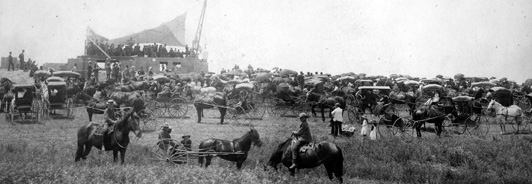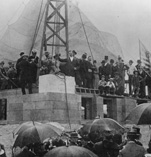A Primer on UNC History
Snyder. Frasier. Carter. Ross.
These are just a few names synonymous with UNC. But all of them — and more — were people who were part of shaping the university’s story.
By Anne Cumming Rice
As UNC marks its 125th year, a look back at how a hill on the south side of Greeley transformed from a normal school with 76 students to a university serving more than 15,000 students each year.
UNC’s Genesis
When UNC was founded, the area where the University Center stands was a “cactus-covered, rattlesnake-infested hill south of town,” writes UNC Professor Emeritus Robert Larson in the book Shaping Educational Change: The First Century of the University of Northern Colorado at Greeley.
Larson, now 87 and living in Denver, was given the task in the late 1980s of telling the first 100 years of the university’s history.
“They gave me my own office at the library that had a big wide window where I could look out,” Larson remembers with a smile. “I got about a year and a half to go out and interview people and write the book.”
Larson tracked down former professors who taught at UNC in the 1920s and ’30s, whose interviews became a foundation for the nearly 500-page book. The history professor also compiled information from photographs and documents in the university’s archives. Larson became UNC’s resident expert on the institution’s history, giving various presentations about it to mark the university’s 100th anniversary.
In 2010, Jay Trask, head of Archival Services, and Mark Anderson, associate professor and reference librarian, co-authored University of Northern Colorado, a pictorial history of UNC. Together they culled through hundreds of photographs in old yearbooks and newspapers and told the story of UNC’s first 100 years through its various name changes.
First called the Colorado Normal School, the two-year teacher-training institution was a dream-come-true for Greeley, whose residents worked for 20 years to get a college in the town. Drawing on their own history of cooperation as Union Colony, Greeley residents raised more than $11,000 in two weeks to help construct the first Normal School building, later renamed Cranford Hall.
The bill to establish the Colorado Normal School was passed by the state legislature in 1889, and classes started the next year in the fall of 1890. It was called a “normal school” because U.S. teacher-training colleges borrowed from the French, who called their pedagogical institutions normal schools. However, in its early years, the normal school was about the equivalent of today’s high school education, as most applicants of that day had finished an elementary curriculum and few had a high-school diploma from an academy.
But admission standards changed as educational reform swept through the country over the next couple of decades. UNC was at the forefront of that reform. In 1911, the institution offered a four-year program and changed its name to Colorado State Teachers College. Two years later, graduate programs were introduced, and by 1930, doctoral programs were added.
In 1935, the institution became Colorado State College of Education, and the name was shortened to Colorado State College in 1957. Finally, in 1970, the institution was renamed the University of Northern Colorado.
Educational Innovation
Perhaps more important than the various names UNC has been called, though, are the personalities that brought character and change to the university.
One of them was Zachariah Snyder, the university’s second president who served in the leadership role for 24 years. One of his major accomplishments was transforming UNC from a normal school to a collegiate institution. He also pioneered the “model school,” or lab school as it was known for many years, where teachers-in-training could put their knowledge into practice.
In his research for the book he put together with Trask, Anderson became fascinated with Snyder and what he brought to the university.
“He was very interested in how children learn,” Anderson says, “and emphasized what it took to be a good teacher.”
In a time when the idea of children learning through play was rare, the lab school had a playground and instituted recess as part of the school day.
“It was revolutionary,” Anderson says.
Now called University Schools, it operates as a K-12 charter school as part of Greeley-Evans School District 6.
Transformations
Throughout the next several decades, the institution gained an even stronger reputation for being a teacher-training institution. Since teaching at the time was largely considered a profession for women, the college built up its athletic programs to attract more men to attend the school. Under George Frasier, the university’s third president, athletic offerings grew largely through the construction of Jackson Field in 1927 and Gunter Hall in 1928.
The bear became the school’s mascot, replacing the Teachers. And in the mid-20s, athletic teams were competing in the Rocky Mountain Athletic Conference, whose members included the University of Colorado, Colorado State University and the University of Denver.
The 1930s and the Depression brought budget cuts and building closings, but it also had a few bright spots: Little Theatre of the Rockies began in 1934, and it remains Colorado’s longest running summer stock theatre. And in 1936, author James A. Michener arrived to teach social studies at College High, the laboratory school, before earning his master’s degree. His years in Greeley and travel throughout the state became the foundation for Michener’s book Centennial. He became the author of more than 40 books, winning a Pulitzer Prize for Tales of the South Pacific in 1948.
Perhaps the biggest transformations at the university happened after World War II, when returning GIs with funds to spend on a college education changed universities everywhere. UNC added class offerings and new bachelor’s degrees.
“There was an air of optimism and the desire to improve their lives among these GIs and their families,” Trask says. “The university had to change and offer more
to meet the demand that growth brings.”
By the late 1960s, one-fifth of students were majoring in business, nursing or one of the liberal arts, non-education areas.
Today’s University
The 1950s and ‘60s brought a construction boom, with much of the western part of campus being built including McKee, Candelaria and Butler-Hancock halls, and Michener Library.
By the time the institution was renamed the University of Northern Colorado in 1970, it had two colleges and six schools. Fast forward to today, the university’s foundation remains teacher education.
“Our story from normal school to college to university really reflects how UNC has responded to the changing context around it,” says Robbyn Wacker, UNC provost and senior vice president. “Our continued preeminence in teacher preparation remains a great point of pride for our institution. It is the foundation on which we’ve built a comprehensive set of exceptional programs.”
Wacker points to UNC’s other hallmarks — business, nursing, performing and visual arts and strong liberal arts programs.
“As an educator and an administrator I was thrilled to come to UNC," Wacker says. "This institution is the perfect distillation of all the things I value in higher education — student-centered classrooms with the ability to do research."
She also points to the university’s dedicated faculty, its graduate programs
and other unique things happening all over campus including cutting-edge research in everything from cancer rehabilitation to autism.
“From its beginning as a teacher’s college, our university has been guided by a spirit of innovation grounded in the very real needs of our community,” she says. “What we offer here, and what we’ll continue to offer for the next 125 years, is a student-centered academic experience that’s uniquely responsive to the demands of our times.” NV





